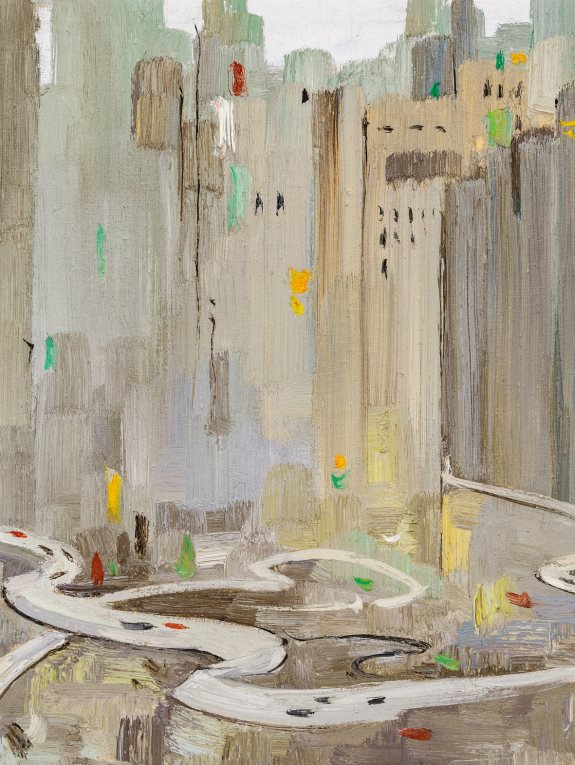
Two Charming Paintings By Top Chinese Artist Wu Guanzhong Whose Work Commands Prices of $30M For Sale With Hindman Auctions in Chicago On September 24th
Two beautiful modern paintings by the late Chinese artist, Wu Guanzhong (1919-2010) are the lead items in Hindman Auctions sale of Asian Works of Art estimated at $1.4m in Chicago on Sept 24th
Jiangnan by Wu Guanzhong

One of China’s leading auction houses, Poly, set a record in 2016 for an oil painting by Wu Guanzhong of $30m and according to the influential publication Artprice, last year Wu had sales of $103m.
Estimates for the two Wu Guanzhong pictures at Hindman are $80,000.00 - $120,000.00 for the painting titled ‘Jiangnan’ and: $120,000.00 - $150,000.00 for ‘Bridge and City’.
Director of Asian Art at Hindman, Annie Wu, says of the Wu Guanzhong paintings: “In these two works we see the distinct style of this great Chinese art innovator, one image, a townscape and one that encapsulates the change that engulfed China. His work is collected because it is visually stunning and because it represents a moment in time in Chinese culture when the impact of modern French art added its own impact to that of Asia.”
‘A snake swallowing an elephant,’ is how Wu once described himself — the snake symbolising the Chinese artist in him, the elephant representing Western influence.
The Wu Guanzhong work titled Jiangnan is a framed oil on canvas work, signed and dated 1996 in Chinese. It is 40 x 50 cm in size.
Wu Guanzhong was from Yixing, a city in the Jiangnan region. Jiangnan, literally “river south (江南)”, refers to lands immediately to the south of the lower reaches of the Yangtze River, including cities like Nanjing, Wuxi, Suzhou, Shanghai. Wu Guanzhong painted a lot of scenery of his hometown and the nearby region, which is characterized by many rivers and bridges as seen in this stunning image.
Throughout his career, Wu revisited the motif of Jiangnan to capture the region's tranquil beauty, giving full play to his homesickness after decades of living in Beijing. Wu traveled frequently in Jiangnan in the firm belief that he would find a way to show its beauty in oil on canvas. He said of it: "I love the gloomy spring days," and added, "Black, white and gray are the main tones of Jiangnan. It thus became the base on which my works are grounded, and also the start of my career."
Born in 1919 in the Jiangsu province of eastern China, Wu Guanzhong is now viewed as one of the most important Chinese painters of the 20th century. He’s renowned for his landscapes, which fuse Western and Oriental artistic traditions, the result, partly, of three years’ study at the École Nationale Supérieure des Beaux-Arts in Paris between 1947 and 1950.
Wu was born the son of a village schoolteacher. He studied initially at the National Academy of Art in Hangzhou, under Lin Fengmian, a painter often called the ‘father of Chinese modernism’.
Then he moved to Paris in 1947, where he was particularly drawn to the work of Pissaro, Cezanne and Van Gogh. Returning to China in 1950, he found himself out of step artistically, the Communist authorities favouring a Social Realist style that featured heroic workers, farmers and soldiers. And now his life mirrored the cultural change sweeping the country.
In 1966, at the start of the Cultural Revolution, Wu destroyed many of his oil paintings, for fear of what the Red Guards would make of them if they searched his house. But he was banned for seven years from painting; denounced as a ‘bourgeois formalist’; and banished from Beijing to the remote countryside to perform manual labour far from his wife and family.
Finally in the mid-1970s, Wu was allowed to return home and paint again — and over subsequent decades he became one of his country’s most revered artists. The year before his death — aged 90, in 2010 — he received two major retrospectives: one at Shanghai Art Museum, and another at the National Art Museum of China in Beijing.
Below: signed Wu Guanzhong, dated 1996 and titled in Chinese on the reverse.
50 x 60 cm
吳冠中
都市
1996年作,油畫

Bridge and City by Wu Guanzhong
Wu Guanzhong(1919-2010)Bridge and City is a framed oil on canvas work, signed and dated 96 in
About Us
About Hindman
Hindman is one of the nation’s leading fine art auction houses offering holistic solutions that connect cities nationwide to the global art market by providing expertise across all categories, sales channels and price points. Hindman operates more salerooms in the United States than any other auction house and conducts over 100 auctions a year in categories such as fine jewelry and timepieces, contemporary art, 20th century design, rare books, furniture, decorative arts, couture, Asian works of art, Arts of the American west, numismatics, and more. Hindman was formed through the acquisition of two premier auction houses, Leslie Hindman Auctioneers (est.1982) and Cowan’s Auctions (est. 1995). Headquartered in Chicago, Hindman is home to 150 employees, with additional offices in Atlanta, Cincinnati, Cleveland, Denver, Milwaukee, Naples, Palm Beach, Scottsdale and St. Louis. Visit hindmanauctions.com for more information.
Contacts